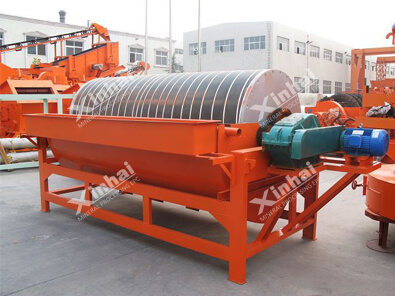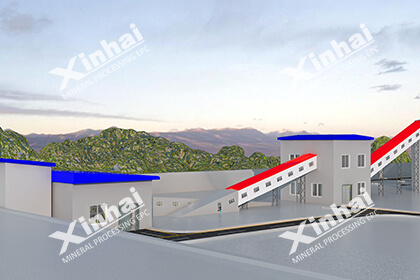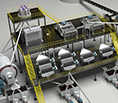Optimizing the Production of High-Purity Quartz Sand
 Essow
Essow
 Apr 13, 2023
Apr 13, 2023
 961
961
If you want to know more details about equipment, solutions, etc, please click the button below for free consultation, or leave your requirements!
High-purity quartz sand is a critical raw material used in a wide range of industries, including semiconductors, solar panels, and high-tech applications. At its core, high-purity quartz sand is comprised of silica, a mineral with a unique set of properties that make it ideal for a variety of industrial applications.
01What are the most common applications of high-purity quartz sand?
Back1. Semiconductors: High-purity quartz sand is a crucial raw material used in the production of silicon wafers for the semiconductor industry. The purity and consistency of the quartz sand are critical to the quality and performance of the final product.
2. Solar panels: High-purity quartz sand is used to produce the silicon cells that convert sunlight into electricity in solar panels. The quality and consistency of the quartz sand are essential to the efficiency and durability of the solar panels.
3. Optics: High-purity quartz sand is used in the production of optical fibers, lenses, prisms, and other optical components. The purity and high-temperature resistance of the quartz sand make it ideal for these applications.
4. Ceramics: High-purity quartz sand is used to produce high-quality ceramics for various applications, including laboratory equipment, electronic components, and refractory materials.
5. Advanced coatings: High-purity quartz sand is used to produce advanced coatings for various applications, including corrosion-resistant coatings, anti-reflective coatings, and coatings for high-temperature environments.
6. Electronics: High-purity quartz sand is used in the production of various electronic components, including transistors, diodes, and capacitors.

(High Purity Quartz)
02What are the processing techniques used to produce high-purity quartz sand?
BackThe production of high-purity quartz sand involves several processing techniques to ensure the material meets the stringent standards of the industries it serves. Here are some of the key steps involved in the process:
1. Mining: The first step in producing high-purity quartz sand is to mine the raw material. Quartz is typically extracted from open-pit mines or underground mines using heavy equipment.
2. Crushing: Once the quartz has been mined, it is crushed into small pieces to create a uniform size distribution. This step is critical to ensuring that the quartz sand produced later in the process is of consistent quality.
3. Washing: The crushed quartz is then washed to remove any impurities or debris that may be present. This step helps to further refine the material and ensure that it meets the high standards of purity required by the industries it serves.
4. Grinding: After washing, the quartz sand is ground into a fine powder using specialized equipment. This step is essential for producing high-purity quartz sand that is consistent in size and shape.
5. Purification: The final step in the process involves purifying the quartz sand to remove any remaining impurities. This is typically done using a combination of chemical and physical processes, such as acid leaching and high-temperature treatment.
6. Magnetic separation: This process involves using a magnetic field to separate magnetic minerals and impurities from the non-magnetic quartz sand. Magnetic separation is an effective method for removing iron and other magnetic impurities from the sand, which can affect its purity and performance in certain applications.

(Quartz Sand Processing Flow Chart)
7. Acid leaching: This process involves treating the crushed and ground quartz sand with a strong acid, such as hydrochloric acid or sulfuric acid, to remove any remaining impurities. Acid leaching is a highly effective method for purifying quartz sand, but it requires careful handling to prevent environmental contamination and ensure worker safety.
8. High-temperature treatment: After acid leaching, the quartz sand may be subjected to high-temperature treatment to further refine the material and remove any residual impurities. This process involves heating the sand to temperatures of up to 1500°C in a specialized furnace, which can help to improve the material's purity and consistency.
9. Electrostatic separation: This technique involves using an electrostatic charge to separate different minerals and impurities from the quartz sand. Electrostatic separation is a highly effective method for removing certain types of impurities, such as feldspar and mica, which can be difficult to remove using other methods.
10. Classification: After grinding, the quartz sand may be classified into different size fractions using specialized equipment. This step ensures that the resulting sand is of uniform size, which is important for certain industrial applications where consistency is critical.
11. Drying: Depending on the application, the quartz sand may need to be dried to remove any residual moisture. This is typically done using specialized drying equipment that can handle high temperatures and rapid drying times.
12. Packaging: Once the high-purity quartz sand has been produced and tested for quality, it is typically packaged into bags or other containers for shipment to customers. Packaging is an important step in ensuring that the material remains clean and free of contaminants during transport.
In addition to these processing techniques, there are several other factors that can affect the quality of high-purity quartz sand. For example, the type of quartz deposit and the geological conditions under which it formed can impact the purity and consistency of the resulting material. Similarly, the use of advanced equipment and technology can help to produce higher-quality quartz sand with greater consistency and efficiency.
Throughout each stage of the process, quality control measures are in place to ensure that the resulting high-purity quartz sand meets the exacting specifications of the industries it serves. This includes testing for purity, consistency, and particle size distribution, among other factors.
Overall, the production of high-purity quartz sand is a complex and highly specialized process that requires a combination of advanced equipment and experienced personnel to ensure that the resulting material is of the highest quality.
If you want to know more about quartz ore processing, please click the link to see details.
03What are some of the new technologies being developed for quartz extraction and processing?
BackThere are several new technologies being developed for quartz extraction and processing that aim to improve efficiency, reduce environmental impact, and increase the purity and consistency of the resulting quartz sand. Here are some examples:
1. Advanced sensors and automation: New sensor technologies are being developed that can help to improve the efficiency and accuracy of quartz mining and processing operations. For example, sensors can be used to monitor the quality of the raw material in real-time, allowing for more precise and efficient processing. Automation technologies are also being developed that can help to reduce labor costs and improve overall efficiency.
2. Sustainable mining practices: The mining industry is exploring new ways to reduce the environmental impact of mining operations, including the use of renewable energy sources, recycling of water, and the implementation of sustainable mining practices. For example, some mining companies are using GPS technology to minimize the impact of mining on natural habitats and reduce the amount of waste generated.
3. New processing techniques: Researchers are developing new processing techniques that can help to improve the purity and consistency of high-purity quartz sand. For example, new acid leaching techniques are being developed that can reduce the amount of waste generated and improve the overall efficiency of the process. Similarly, new magnetic and electrostatic separation techniques are being developed that can improve the quality of the final product.
4. Green energy applications: High-purity quartz sand is becoming increasingly important in the production of green energy technologies such as solar panels and batteries. Researchers are exploring new ways to optimize the production of high-purity quartz sand for these applications, including the use of new processing techniques and the development of new types of quartz deposits that are better suited for these applications.
Overall, the development of new technologies for quartz extraction and processing is an ongoing process that aims to improve the efficiency, sustainability, and quality of the resulting high-purity quartz sand. These advancements are critical to meeting the growing demand for high-purity quartz sand across various industries and supporting the development of new technologies that rely on this important raw material.
What are the advantages of using renewable energy sources in high-purity quartz sand production?
Using renewable energy sources in high-purity quartz sand production offers several advantages, including:
1. Reduced carbon emissions: Renewable energy sources such as solar, wind, and hydropower generate electricity with little to no carbon emissions. This can help to reduce the carbon footprint of high-purity quartz sand production and support efforts to combat climate change.
2. Lower operating costs: Renewable energy sources can be cheaper to operate and maintain than traditional fossil-fuel-based energy sources. By using renewable energy sources to power their operations, mining companies can reduce their energy costs and improve their bottom line.
3. Improved sustainability: Renewable energy sources are often more sustainable than traditional energy sources, as they have lower environmental impacts and are typically replenished naturally. By using renewable energy sources in high-purity quartz sand production, mining companies can reduce their environmental impact and support more sustainable practices.
4. Increased independence: By using renewable energy sources, mining companies can become more independent of traditional energy sources such as oil and gas. This can help to reduce their exposure to price volatility and supply disruptions associated with traditional energy sources.
What are some challenges that mining companies face when adopting renewable energy sources?
While there are many benefits to using renewable energy sources in mining operations, there are also some challenges that mining companies face when adopting these technologies. Here are some examples:
1. High upfront costs: The initial cost of installing renewable energy systems such as solar panels or wind turbines can be high. This can be a barrier to adoption for some mining companies, especially small or medium-sized enterprises that may not have the financial resources to make the necessary investments.
2. Intermittency: Renewable energy sources such as solar and wind power are intermittent, meaning that their availability can fluctuate depending on weather conditions. This can make it difficult to rely on these sources for consistent power supply, especially in remote mining locations.
3. Storage: Energy storage is an essential component of using renewable energy sources in mining operations. However, energy storage systems can also be expensive and require specialized knowledge to operate and maintain.
4. Regulatory barriers: Regulations and policies related to renewable energy can vary widely between countries and regions. This can create uncertainty for mining companies looking to adopt renewable energy technologies, as they may face regulatory barriers or challenges in obtaining permits or financing.
5. Technical challenges: Using renewable energy sources in mining operations can present technical challenges related to equipment and infrastructure. For example, mining equipment may need to be modified to accommodate renewable energy systems, and power distribution networks may need to be upgraded to handle the new energy sources.
Overall, while there are many benefits to using renewable energy sources in mining operations, there are also several challenges that must be overcome. Mining companies must carefully evaluate these challenges and develop strategies to mitigate them in order to successfully adopt renewable energy technologies and reap their many benefits.
What are some strategies that mining companies can use to reduce the upfront costs of adopting renewable energy sources?
Mining companies can use several strategies to reduce the upfront costs of adopting renewable energy sources. Here are some examples:
1. Government incentives: Many governments offer incentives and subsidies for companies that invest in renewable energy technologies. These incentives can take the form of tax credits, grants, or low-interest loans. Mining companies can take advantage of these incentives to help offset the upfront costs of investing in renewable energy sources.
2. Power purchase agreements (PPAs): Power purchase agreements are contracts between a renewable energy provider and a customer, in which the customer agrees to purchase a specified amount of renewable energy over a set period of time. PPAs can help mining companies to lock in a predictable, long-term energy price, which can make it easier to justify the upfront costs of investment in renewable energy systems.
3. Energy efficiency measures: Before investing in renewable energy systems, mining companies can undertake energy efficiency measures to reduce their overall energy consumption. This can include upgrading equipment and infrastructure, implementing energy-efficient lighting and HVAC systems, and improving operational practices to reduce energy waste. By reducing overall energy demand, mining companies can reduce the size and cost of the renewable energy systems they need to invest in.
4. Collaborative investments: Mining companies can collaborate with other companies, governments, or organizations to invest in renewable energy systems. This can help to spread the upfront costs across multiple stakeholders, making it easier for each party to justify the investment.
5. Innovative financing models: There are several innovative financing models that mining companies can use to reduce the upfront costs of adopting renewable energy sources. For example, some companies are using crowd-funding or impact investing to raise funds for renewable energy projects. Others are exploring new financing models such as green bonds or energy service agreements.
04To Wrap Up
BackIn conclusion, high-purity quartz sand plays a critical role in various industries, including semiconductors, solar panels, and advanced coatings. The production of high-purity quartz sand is a complex and labor-intensive process that requires specialized equipment and personnel to extract the mineral from the earth's crust. However, the industry is constantly evolving, with new processing techniques, innovative technologies, and sustainable practices being developed to improve efficiency, reduce environmental impact, and increase the purity and consistency of the resulting quartz sand.
As the demand for high-purity quartz sand continues to grow, so does the importance of optimizing its production. Researchers are exploring new processing techniques, developing new types of quartz deposits, optimizing the production process, and improving sustainability through the use of renewable energy sources and recycling programs. By embracing these advancements and making the necessary investments, mining companies can meet the growing demand for high-quality quartz sand and support the development of new technologies that rely on this important raw material.
Overall, the production of high-purity quartz sand is a critical component of many industrial processes, and the industry must continue to innovate and evolve to meet the demands of a changing world. With a focus on sustainability, efficiency, and innovation, the high-purity quartz sand industry can continue to grow and thrive for years to come.
 +86 13810565920
+86 13810565920 xlyin@xinhaimining.net
xlyin@xinhaimining.net




 Message
Message Chat Now
Chat Now




















